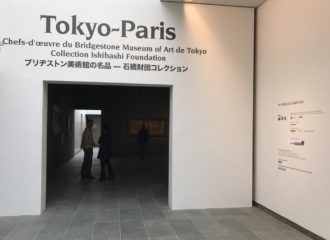It is well known that there are outstanding works of fine art in Japan, this island nation in the Far East, but only a few experts know that there are actually several collections of Western art in addition to Japanese art. Nevertheless, several Japanese art museums with collections of magnificent works of modern French paintings have recently started to show the paintings in Europe — no doubt as a reminder of their existence.

Fig. 1: Pierre-Auguste RENOIR, Mlle Georgette Charpentier Seated,1876, Courtesy of Bridgestone Museum of Art, Ishibashi Foundation Dr. Miura Atsushi
The Masterpieces from the Bridgestone Museum of Art exhibition held at the Musée de l’Orangerie in Paris this year (April 5 to August 21, 2017) attracted a lot of attention. The exhibition introduced the most important works in the collection of mainly modern Western art acquired by Ishibashi Shojiro (1889–1976), the founder of the Bridgestone Corporation. It must be said that the choice of the Musée de l’Orangerie, famous for its paintings of Water Lilies by Monet, a painter who loved Japanese art, as the venue for the exhibition was an excellent one. The exhibition featured a total of 76 paintings and sculptures including Mlle Georgette Charpentier Seated (Fig. 1) by Renoir, Mont Sainte-Victoire and Château Noir by Cézanne, and Picasso’s Saltimbanque Seated with Arms Crossed. The exhibition also included masterpieces of modern Japanese painting in the Western style including A Gift of the Sea (Fig. 2) by Aoki Shigeru, and Black Fan by Fujishima Takeji.

Fig. 2: AOKI Shigeru, A Gift of the Sea, 1904
Courtesy of Bridgestone Museum of Art, Ishibashi Foundation
The Paris exhibition follows in the footsteps of the Japan’s Love for Impressionism exhibition organized at the Bundeskunsthalle in Bonn, Germany from October 2015 to February 2016 in the sense that it introduces a Japanese collection of Western painting to Europe. The Bonn exhibition was designed to show Impressionist and other modern French paintings acquired by the entrepreneurs Matsukata Kojiro, Ohara Magosaburo, Ishibashi Shojiro, and other Japanese collectors alongside ukiyo-e prints collected by Monet and Western-style Japanese paintings. It was the ideal opportunity to demonstrate the role of cross-fertilization in the arts with Japanese collectors buying Impressionist paintings influenced by ukiyo-e prints, which in turn inspired modern Japanese painters working in the Western style (Fig. 3).

Fig. 4: The Masterpieces from the Bridgestone Museum of Art exhibition held at the Musée de l’Orangerie in Paris in 2017
Photo by author
Important museums all over Japan, including the collection of the Ishibashi Foundation, lent works to the exhibition in Bonn while the exhibition in Paris was designed to introduce masterpieces from one museum in a test of the caliber of an individual collection. I understand that there were nearly 4,000 visitors a day, a good figure for an exhibition in Paris, so it obviously attracted a lot of interest from art lovers in Paris. I had the opportunity to visit Paris during the exhibition. So, I visited the Musée de l’Orangerie with a view to checking on a collection that I am used to seeing at the Bridgestone Museum of Art (Fig. 4).
Nevertheless, when I entered the museum I was not a little astonished at how much the exhibition exceeded my expectations. First of all, it did not start with the modern Western paintings, but with Aoki Shigeru’s A Gift of the Sea, a modern Japanese painting in the Western style. Ishibashi Shojiro bought Western-style modern art by Aoki, Fujishima Takeji and others before he began to collect Impressionist and other modern French paintings. The exhibition respected this formative history while impressing on the viewer that this was a collection from Japan.
The exhibition progressed slowly from modern French painting to twentieth century abstract painting, but what intrigued me was how the impression of the works differed compared to when I saw them formerly at the Bridgestone Museum of Art. There was an oddly fraught yet pleasant feeling of tension. Perhaps the source of it was the Western style of display with its awareness of the bilateral symmetry of each wall. Or, possibly it was the exquisite combinations of sculpture and paintings (e.g. Rodin and Cézanne) (Fig. 5).

Fig. 5: “… the collection from Japan was filtered through the French esthetic sense.”
Photo by author
It may also have been the seamless flow that invited the viewer’s gaze, or the wonderful lighting effects, or the differences in air and humidity levels. In any case, it is for certain that as I walked around the venue turning these thoughts over in my mind, I had a series of fresh experiences as if I were seeing the works for the first time. To sum up, the collection from Japan was filtered through the French esthetic sense. The experience was an eloquent illustration of how works of art appear different if the exhibition environment is changed.
In any case, Japanese cultural exports in the realm of the fine arts are by no means limited to antiques, ukiyo-e prints, and contemporary art. The reception of Western art in Japan, that is, the encounter between the art of Japan and the West, is also an important art phenomenon. It is significant to show how much Western painting can be found in Japan. The West probably perceived the Paris exhibition as a kind of homecoming, but was the exhibition also not noteworthy for introducing modern Japanese painting in the Western style, the hybrid that emerged out of the blending of two esthetic sensibilities, and for imparting messages about Japanese culture? There is a tendency to draw a straight line from the pronounced traditions of the pre-Edo period to the current sub-culture fads, but I would suggest that the key to understanding Japanese culture is to shed new light on the modern art that brought forth unique works of art in the Meiji, Taisho and early Showa periods.
Translated from an original article in Japanese written for Discuss Japan. [November 2017]
